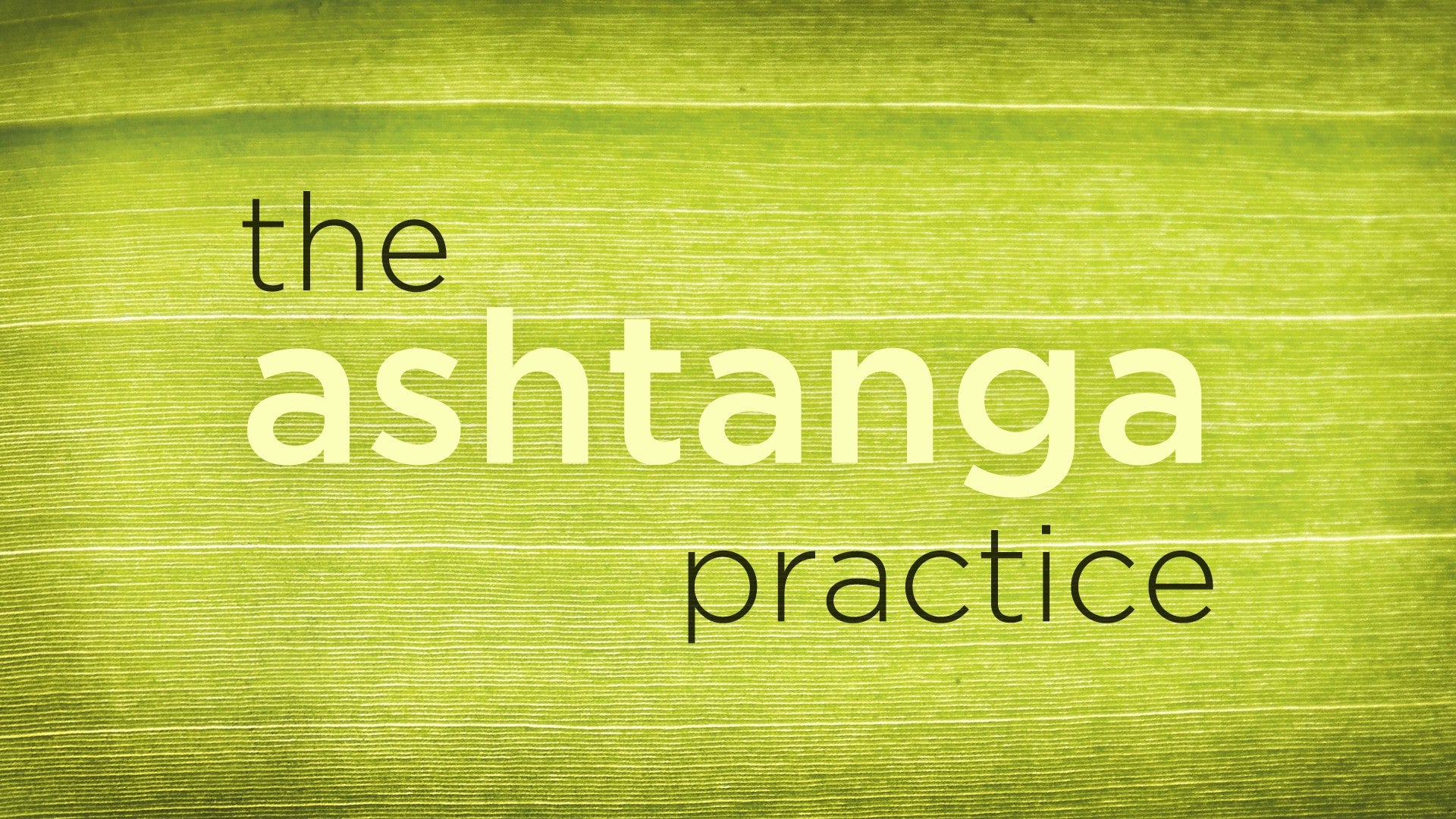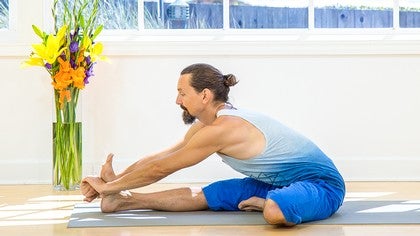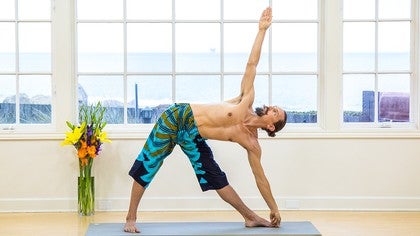Description
About This Video
Transcript
Read Full Transcript
Hello and welcome. It's a pleasure to have you with us. I won't try to define yoga because that's a vast subject, and I think yoga is practiced in a multitude of ways. But it seems like all yoga and related practices do have an element of bringing us back to an internal awareness, an awareness of what's going on inside. So Ashtanga has some great ways for us to find that internal awareness throughout our daily practice, and the best and most powerful and efficient way is simply focusing on the breath. The breath is the amazing gateway, the portal to that internal awareness. An internal awareness, the more that you can be aware of what's going on inside, will actually quicken and develop you in yoga practice at a much more rapid pace. It's a great way to avoid injury as well because your awareness is so much on the internal. Nowadays we have so much trying to draw our awareness externally. It's great if you can find your breath and keep the awareness inside. So in Ashtanga we use a breath with sound. So that's really useful as well because your ears can constantly be listening to your own soundtrack, which is your own breath. So making that interesting whispering noise as you breathe can be super, super, super useful. So let's look at some techniques just to begin here, and that listening to the breath will in fact start to guide our entire practice happening not from the outside in, but from the inside out. So how shall we breathe? Let's work on the position of the mouth. Keep your lips in a slightest, slightest smile. So lips will be together, curled up at the corners into a slight smile. But have your jaw slightly ajar. So let your upper and your lower teeth have some separation. And then take the very tip of your tongue and take the tip of your tongue and rest it just behind the upper teeth anywhere where it can be comfortable and it can find peace and not be searching around. Now creating that whole mudra or seal with the mouth, lips curled up slightly together, the upper and lower teeth slightly separate, and the tongue just resting. That should help to dome up and to soften the back of the throat. So at the back of the throat, you've got the soft palate. You can feel with your tongue now if you go there. You can draw your tongue all the way back to the back of your throat and feel where the throat starts to soften. Think about that area rising up. Again, replace the tongue to the just behind the upper teeth and see if here you can start to whisper and draw a breath slowly and subtly past the back of the throat, making a noise. Maybe you can find it easier to make the noise on the exhale or the inhale. That's all right.
Just keep practicing. Let that be a central part of your practice and allow there to be space between the breaths. Now, tied with this entire breathing system, of course, will be Bandha, the internal energetic lock, which is reflected on the physical level of keeping the lower abdomen and even pelvic floor engaged as we practice this breath. For more on that, you can watch the tutorial on restraint. But for today, let's just think about exhaling extra breath out, pushing out a little extra breath and seeing if you naturally recruit some musculature in the lower abdomen to draw in. Try to keep that locked as you inhale. And again, exhaling out extra breath, seeing what muscles are recruited and inhaling, keeping those muscles engaged. So using that, you'll start to see that the breath actually shapes the torso. You might see the narrowing of the abdomen. That's why I'm able to demonstrate that for you today. Exhaling that when you push extra breath out, the lower abdomen draws in, trying to keep that drawn in so that when you inhale, breath floods the ribs, expanding the rib cage, lifting the chest, even broadening the collarbones. So try to practice a few of those, keeping the chest lifted even as you exhale and trying to keep lower abdomen engaged even as you inhale. So as we allow the breath to shape the torso, we'll feel that it actually creates movement through the spine and thus through the shoulders, through the hips. And from that central foundation of Bandha, the breath guiding the torso can guide all of the movements that we do. So exhale again completely, push extra breath out, find Bandhas if you're aware of them, don't worry about it if you're not. Measuring breath at the back of the throat, take an inhale and feel the collarbones rise, the shoulders roll back and down and feel the arms start to lift ever so slightly in response to the breath. Finish the movement, finish the breath, begin the exhale and then allow the hands to again be guided back to the floor and we'll do a few of these together. Join me inhaling, hands floating up, finish the movement, finish the breath and begin the exhale not moving and then allow the hands to go back to a comfortable resting place. Finish the movement then finish the breath again. So when we practice this way, instead of pumping the body, we're instead letting the breath be the actor, be the cause of all of our movements. So you can come back to your comfortable resting seated position and now we'll come together in standing and put some of this technique into practice in the sun's salutations. Bring your feet together at the top of the mat or stand in any position that you're comfortable in, find your neutral Samastitihi position and try to apply that same technique where the inhales open the chest, draw the collarbones broad and the exhales keeping the chest lifted close the abdomen towards the spine. Inhaling, opening the chest, collarbones lift, hands float open and up a little and exhale, bring the hands down. Again inhaling, letting the arms float up and exhaling waiting for the breath to guide you back to a neutral position. We'll take on some new movements here, inhale, bring the hands together, maybe you see your thumbs and with this exhale allow the exhaling to close the abdomen and draw you forward as you drop the head reaching down. Inhale and just lift the head, following the breath to look forward and ashtal, exhaling as you fold the head down once more. Nava, inhale and keep the breath long as you ride this inhale all the way up, see your thumbs, exhale back to your neutral Samastitihi. We'll do one more like that. Ekam, inhale, begin the exhale here not moving and then ride the exhale down. So really restrain yourself from jumping forward or jumping back. Trini, inhale and then ashtal, wait for the exhale, close the abdomen and let that draw the chest to the thighs. Nava, inhale and ride that breath as the chest becomes buoyant, floating up the arms, seeing thumbs.
Inhale to Samastitihi. One more together, just try to breathe at the same pace. Great, so it might seem remedial, it might seem easy for you but don't be fooled. This is actually a very difficult practice. The people who have the most trouble with it in my limited experience are the teachers, the really experienced practitioners because they know the posture so well, they're off to the next one, off to the next one, off to the next one. So instead find that distance, find that space between your breaths and allow yourself that restraint so that you're practicing truly from the inside out. So we'll apply Sun Salutation A. Now we'll learn Chaturanga, Upward Dog, Downward Dog and some modifications but most important, keep the idea that you're going to wait for the sound of breath before you move. Let every movement be encapsulated in breathing. So let the breath be the cause. So Chaturanga then, we'll take a look at modifications here. From your Trini position with the head up, you can exhale and as you're exhaling, step the feet back. You're welcome to lower down onto your knees and even bring the chest all the way down the mat. That's a fine variation of Chaturanga that you might need at some time. Rolling the shoulders back and down and then to Upward Facing Dog, punch, inhale, flatten the feet on the mat, draw the chest forward through the shoulders, rolling back and down. Elbows can stay bent but drawn in towards the ribs and then to Downward Dog, exhale, bend your knees, tuck the toes under, find yourself in all fours, still exhaling, closing the abdomen, lifting the hips to the back corner of the room. Just take one full deep breath here if you're following with us. And then Sapta, interestingly, inhale, and during the inhalation, draw the feet forward, head up, Ashta, exhale and fold, nava, inhale, come up, and exhale, Samastitihi. So let's do another Sun Salutation. We'll start from Samastitihi here and actually perform one together. We'll do the modifications, experiment with them. Ekam, inhale, drawing the hands up, seeing the thumbs meet together, wait here, exhale and hear the sound of your breath, closing the abdomen as that guides you down towards the mat. Knees can be bent, that's fine. Threeny, inhale, let the chest become buoyant and float forward. And then here, Chaturwadi, exhaling, exhaling, step the feet back, lower down all the way on the mat, punch, inhale, chest forward, shoulders back, elbows in towards the ribs, and shot, exhale through the all fours position, lifting the hips to the back corner. Take one full deep breath here. Fingers are spread, toes are spread. And then Ashta, inhale, Sapta, inhale, draw the feet forward, head up, exhale, fold forward, and Nava, inhale, rise all the way up, seeing your thumbs meet together, exhale, Samastitihi. And then Ekam, inhale, wait for the breath to move the chest, to roll the shoulders back, to lift the hands, see the thumbs. Seeing the thumbs, wait for the exhale to sound and then follow that breath as the abdomen closes, it draws you further forward down towards the mat. Trini, inhale, allowing the chest to float forward, head up. And Chaturwadi, exhale, stepping back during the exhalation, again, lowering knees, doing a modification, chest might be down, punch, inhale, flatten the toenails, lift the chest forward, roll shoulders back and down, and wait for the sound here, exhaling, as you draw yourself shot into downward facing dog, lifting the hips and take one full deep breath here, spreading fingers, spreading toes, and Sapta, inhale, stepping feet forward, riding the inhale forward, head up, Ashta, exhale, and fold, drop the head, and nava, inhale, rise all the way up, exhaling, to Samasthiti. So our friend Chaturanga, a position that will come to many, many times, something I've modified there, but ideally you want just your hands and your feet to be on the mat, and sometimes that will be available to you, and at those times, try to see your elbows are about 90 degrees, the shoulders rolled back and down, keeping that broad collarbone experience, so it's really like Samasthiti, just with a bend of 90 degrees at the elbows. So if that's available to you, we'll do a full sun salutation A, with upward dog and downward dog, full and unmodified. Of course, if you want to modify at home, just keep modifying, it's great. Let's try and do it on the breath. So exhale completely, and exhale, into a exhale, waiting for the breath to guide you forward. Trini, inhale, not moving until you hear the sound of the breath. So not moving, Chatur moving, punch, inhale, and then following breath, and not moving, shot, exhale, and then following the sound of breath, invited to come to downward facing dog. We'll take three breaths here now, spreading fingers and toes, keeping root knuckles down, one, allowing the shoulders to soften as you roll the tricep area to the face, two, and still feeling every exhale fully empties out, recruiting the musculature of the lower abdomen and pelvic floor, three. Sapta, inhale, wait for the sound, and allow that to guide you forward. Ashta, exhale, na rushing, nava, inhale, and exhale, samastitihi. Great. So that might become a more approachable practice as you keep working with time. Of course, coming forward on the inhale is tricky, but just keep practicing that. Sun Salutation B will present even more challenges. So we'll really have to stretch the breath long, try to keep that nice seal on the lips with the tongue behind the upper teeth, measuring air at the back of the throat, and we'll just dive into it right here. Exhale completely, and exhale, bend the knees, drop the hips, allow the hands to rise up, see thumbs. Dwe exhale, fold forward, drop the head, see the nose. Trini, inhale, allow that breath to guide the chest forward.
Chaturwadi, begin your exhale here, and then jump back during the exhale. Pancha, inhale, upward facing dog. Shat, exhale, downward facing dog. Exhale completely and down dog. Now sapta, inhale. Maybe you drop your left heel on the mat first, and inhaling, draw your right foot forward, still inhaling. Let the hips come towards square as you see the thumbs meet, shoulders down, and ashta. Exhale, draw the hands to the front of the mat, still exhaling, pick up your left heel, draw your right foot back, still exhaling, any chaturanga variation, finish the exhale, nava, inhale, nice, long, slow, controlled, measured breath. And dascha, exhale, lift the hips, hit all the way into downward dog. And then a karasha, inhale, left foot forward, heels in a line. Dwa dascha, exhale. Bring your left foot back, shoulders down, and chaturanga, wait for triyog dascha, hear the sound of breath, guide you forward to up dog. And chaturg dascha, exhale, downward facing dog. We'll just take one breath here for today. Pancha dascha, inhaling, stepping the feet or hopping the feet forward, head up, shoulders, exhale, fold forward, drop the head, sapta dascha, inhale, bend your knees, swing the hands up, and exhale, samastitihi. We'll do one more together. Let's just follow the sound of breath and see if you can stretch the breath long, being guided by breath through sun salutation B. Afterwards, we'll come to a seated position. Exhale completely, achim inhale. Dwe exhale. Trini inhale. Chaturi exhale. Pancha inhale. Shat exhale. Sapta inhale. Ashta exhale.
Navainhale. Dascha exhale. Hekha dascha, inhale. Dwa dascha, exhale. Trayug dascha, inhale. Chaturg dascha, exhale. Let's take one full deep breath here before we jump to seated.
Coming through to a seated position, begin the inhale, try to ride that inhale by stepping or jumping the feet forward, coming through to a seated posture, and then finding any comfortable crossed-legged pose. You can simply cross the legs or take lotus of any variation. And remember that our practice here is not about learning to jump through or jump up, but we're trying to guide awareness internally. So the bandha, the breath, the entire practice itself might just be a tool and a technique for you to have that internal awareness working for you. So remind yourself at the end of every practice, I highly encourage you to take a sitting practice at the end of any kind, for today just sit, breathe, hear the sound of breath, notice how the mouth is making that sound, and if you can start to use bandha and feel the movements of breath naturally flow through the torso, great. Thank you for making time for this. I truly hope that it's a benefit for your practice and for your life.
The Ashtanga Practice: Dylan Bernstein
Comments
You need to be a subscriber to post a comment.
Please Log In or Create an Account to start your free trial.













